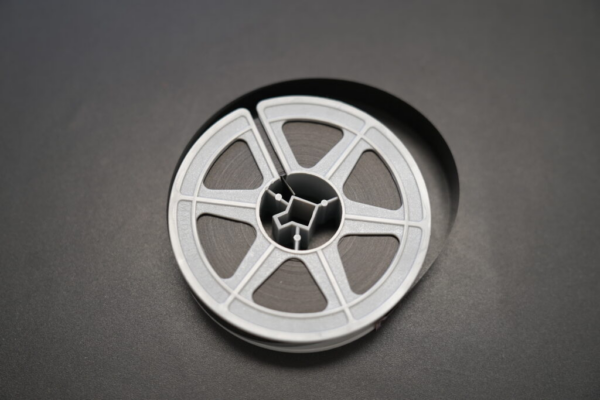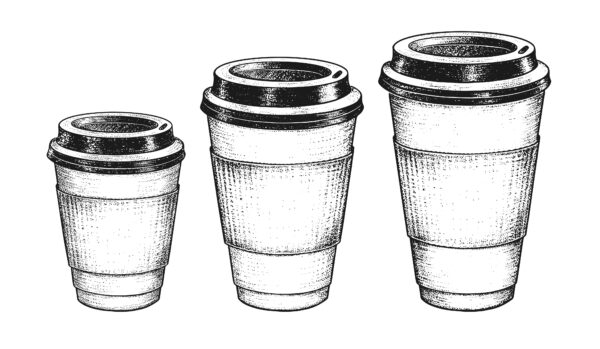If you’re sitting on a large volume of microfilm in need of digitization but are overwhelmed by the task, we’re here to help. In this article, you’ll discover the essentials of managing large-scale microfilm scanning projects, including considerations about cost, timeline, and logistics. From understanding microfilm to planning and execution, let’s demystify this process together.
What Is Microfilm?
Microfilm is a specialized type of record storage. Original files — be they hard copies, images of books, newspapers, or similar items — are photographed and then reproduced on this film-like material. The term “microfilm” stems from the format of these images, which are miniature reproductions of the original documents. Specifically, the files may be reduced to either 16mm or 35mm formats.

Microfilm can be produced in various formats. For instance, simplex format presents one image per frame, while duplex format allows for two stacked images per frame. In addition, microfilm comes in different lengths, typically as either 100-foot or 215-foot reels.
The incredible aspect of hard copy microfilm is its compactness and data capacity. Let’s take a banker’s box of paper files as an example; it usually holds roughly 2,500 pages. One reel of simplex 100-foot microfilm, on the other hand, also holds approximately 2,500 images. And, you can store about 90 to 100 reels of microfilm in that same bankers box. If you do the calculation, 2,500 images on one reel multiplied by 100 reels equates to 250,000 images. That’s a hundred times more data stored in the same space that could otherwise contain only 2,500 pages.
Lastly, when stored properly, microfilm has a shelf life of roughly 500 years. Therefore, compared to hard copy files, it has a remarkably long lifespan that can be beneficial for future preservation and use.
Defining A “Large” Microfilm Scanning Project
Microfilm scanning projects come in all sizes, though when we refer to a large project, we typically mean one comprising of more than 2,000 rolls. If you have around 100 rolls, that’s classified as a medium-sized project. On the other hand, if you have 10,000 or more rolls, that’s what we view as a very large project.

The reason it’s important to differentiate between small, medium, and large projects, or even very small projects, such as just a handful or a couple dozen rolls, is that depending on the size of your project, we’re able to scale our resources effectively to deliver a successful final outcome for you.
Project Considerations
As cliché as it may sound, every project is unique. Even two projects that both have 3,000 rolls of simplex 100-foot film from the same type of agency, such as a police department, there will still be nuances that make these projects distinct. Because of this, we approach each task with a customized process. This involves developing unique steps to transition your project from analog to digital, from hardcopy microfilm to digital images, ensuring that every requirement is addressed. Some of the considerations that will go into your project are described below:
Price
The price for your scanning job will be based upon the quantity of microfilm rolls you have. For example, if you have 2,000 rolls, it’s going to be different in price compared to 15,000 rolls. Typically, the more rolls you have to scan, the lower the unit price will be. However, this unit price will undoubtedly adjust based on other considerations, not just the quantity. We’ll cover some of these considerations in the scope section further on.

Schedule
Your timeline is one of the critical aspects of large scanning projects. For example, let’s say you have 5,000 rolls that you want to get scanned. After discussing with us, we estimate it will take roughly 3 to 4 months from our Milestone One approval phase. If you are in a rush and need it done in 2 months, that can affect the overall project scope, especially the price and the method of executing the project to ensure it happens within your timeline. On the flip side, if you’re not in a critical hurry, and we have extra time to adjust, we can work with you on considerations based on that flexibility.

Logistics
As the saying goes, “Amateurs think of strategy; professionals think of logistics.”
The scanning and digitizing are the fun parts, but often logistics is a key piece of the overall project puzzle. Consider how the microfilm rolls are going to get from your location to ours. There might be a longer transportation method required; for example, one of our employees flying to your location, renting a vehicle, and driving the rolls back.

Alternatively, we may need to determine the shipping methodology and schedule from wherever you are. If you’re located out of state and have thousands of rolls, you might want to palletize the microfilm in bankers boxes and ship them all at once, or you might prefer to do it in smaller batches. For smaller batches, we will send you our lockable Pelican cases. Then you can send us a couple hundred rolls at a time for a continuous flow of microfilm. The amount of microfilm we have will ensure the project process is ongoing and that it doesn’t get stalled. But you also need to be ready with the material to send.
Regardless of the final logistics plan, it’s important to create a solid plan and ensure it’s ready for implementation before executing the contract and getting started. Coordinating timelines is crucial – if we don’t have the microfilm at our facility for scanning, this can extend the timeline as we won’t have anything to work on. Therefore, when planning to undertake the project together, having a comprehensive logistic plan will play a key role, and we’ll collaborate with you to ensure a smooth project procedure.
Scope
Now, we get to the scope, which is all about how the film will be scanned and what will happen to it once it’s in a digital format. We’ll explore a few items related to scope so you can understand how a project really comes together.
>> File format
The file format can be traditional, such as PDFs, JPEGs, TIFFs, etc., or can be accessed via our secure hosted application, Digital ReeL. Typically, this aspect of the scope doesn’t cause many issues unless you request for something very unique or rare, or maybe certain file types that take longer to process due to their creation method. However, in general, as long as we know the file format ahead of the project, it tends to be pretty seamless. Issues could arise if, after the Milestone proof of concept process, you decide to change the file format or elect to do so mid-project. This can result in minor hiccups, but usually, it’s not a major concern.
>> File delivery
Once the project’s done, the film is scanned, their indices are created, and the formats are developed, you must think about how to actually receive the data because we need to transfer the images and data to you somehow. Standard methods include USB hard drives or we could use SFTP, which is a method for electronic delivery. Or, as mentioned before, you may just access the data through our Digital ReeL application. There are many options for data transfer, but knowing how you want to receive the records once we complete is a key part of the scope to ensure the project is wrapped up properly.
>> Do you have the resources to ingest the data?
Something to consider when you are receiving these images and files, especially on large projects where there’s going to be hundreds of thousands, or even millions of images, is whether you have the resources to ingest that data. A lot of times, people underestimate the resulting data size, which could range from hundreds to thousands of gigabytes, or even terabytes. They may not have sufficient resources on their end to store it. The exact data size remains uncertain until the project is completed, as that’s the nature of digitization. However, there are ways to estimate how much data you will receive, so you can be prepared when you get the files.
How To Get Started
You might be looking at your large microfilm scanning project as a Herculean task due to the sheer volume of records and rolls, leading to numerous images and a considerable amount of data delivered. However, the best approach is to tackle it as if you were eating an elephant – one bite at a time.

Starting off, it’s highly beneficial to consult with someone knowledgeable in the field, such as a representative from BMI or us. These experts can provide valuable ideas and options on how to move forward. Alternatively, you can also choose to talk to multiple companies or conduct independent research through digital conversion company websites, videos, and articles. This research can help you understand the challenges you might face. But conversation with an expert remains our top recommendation.

After that, you might want to consider conducting a sample scan. This approach can be incredibly informative, as it allows you to get a sense of the scan quality, how the records might be indexed, and the file sizes – which can be representative of the entirety of your project. Additionally, it also gives you a glimpse into the manner in which the chosen company operates. However, keep in mind that a sample is a one-off event and isn’t a comprehensive process flow of the entire project.
If you want to take things up a notch, consider running a pilot project, which is essentially a more detailed sample. Typically, samples are hand-done projects. This means that there may not be a process flow as if it was a full-scale task; it’s more of a one-off individual basis to provide a snapshot of what everything will look like and what we are dealing with, among others. However, if you partner with us, one major difference between a sample and a pilot project is that we will actually draft a process flow for the pilot. This will serve as the milestone, or the M1, that we persistently use in our regular projects. So, if you decide to proceed with the rest of the project after the pilot, we already have the M1 accomplished and the process flow ready for your project, making it much easier to move forward.

Now let’s say you do move forward with the project as a whole. You have 5,000 rolls – let’s use that as an example. You may be thinking, “Which ones do I start with? I may not want to do all of them at once, or it’s going to take a while. How do I decide where to start?” You may want to start with the non-active files. If you’re actually accessing this microfilm on a semi-regular basis, it’s probably a certain subset of the entire collection. What you could do is start with the non-active files; you know you’re not going to need to access them during this portion of the project. You can get a large chunk done, and then move towards scanning the active files.
Conversely, you may want to do the active files first. Maybe it’s a small set, maybe it’s a large set, but you want to get those done first because you’re tired of using the physical microfilm and you want the digital images. So you might want to start with those. Think about how you’re using them now, and what makes the most sense for you and your organization.
As we mentioned before, conducting the project in batches can be extremely beneficial. This approach ensures that you don’t have too much work out of your hands at once, allowing you to progressively complete sections of the project. The progress accumulates over time, reflecting an iterative process where the project gradually comes together until it’s fully completed.
Another thing to consider is that even if you are sending batches at a time, or even the whole project at once, you may still get requests for microfilm that is currently out of your hands. So, what do you do if you receive a request and the microfilm isn’t in your possession? The answer is to submit a request to retrieve that record. If you are collaborating with us, we offer our BMI Request System, also known as BRS. This enables you to log into a secured portal, create a request, and then we can process that microfilm, prioritizing it to return it to you as quickly as possible. You won’t need to worry about not having the microfilm on hand. We understand that this is a critical aspect of any project, and you might be thinking, “I can’t access this record if I don’t have it, but I need it.” That is exactly why we created BRS, to provide a seamless way for you to access records, even when you don’t physically have them with you and they may not yet be digitized.
Conclusion
A large microfilm project can indeed seem daunting, but there are ways to simplify the process. The key is to break it down into manageable pieces, rather than viewing it as one giant task. Drawing upon our extensive experience with hundreds of large projects, we can offer recommendations on how to approach your unique project, build a process flow, and devise a comprehensive plan. This ensures that your microfilms are smoothly and efficiently scanned and transitioned from analog to digital, once and for all.
Next Steps
Reach out to us today! Click the “Get Your Quote” button below, fill out the form, and we’ll quickly reply to you to discuss your project.
Further Reading
The BMI Microfilm Scanning Process
Are you wondering what will happen to your microfilm once you hire a company for a digital scanning project? Take a look at our 10-step microfilm scanning process to see how we run our projects. The more you know, the more you’ll trust us!
Types Of Microfilm
Microfilm comes in various types, formats, and lengths – knowing what you have is essential to crafting a successful digitization project.
Dos & Don’ts For Successful Digital Conversion
Digital conversion projects can be simple, but that doesn’t mean they’re easy. In this article we’ll give you some “dos” that’ll get your project moving in the right direction (success!) as well as some “don’ts” that you’ll want to avoid.

